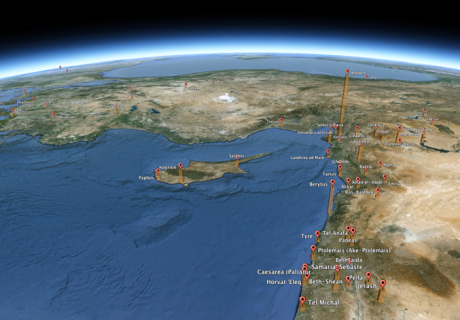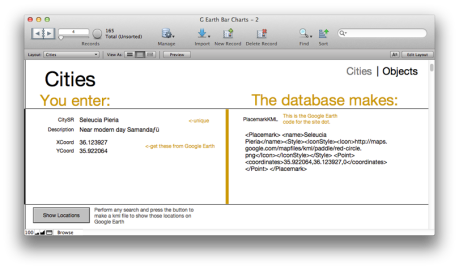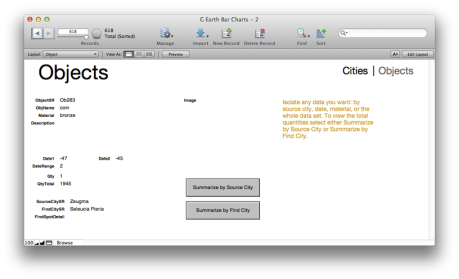This is a draft of the paper which will be given on Thursday morning March 28 at the CAA 2013 conference in Perth, Australia.
Authors: John Wallrodt, Kevin Dicus, Leigh Lieberman, Gregory Tucker
The Pompeii Archaeological Research Project: Porta Stabia, or PARP:PS, has excavated for eight consecutive seasons in the southern portion of Pompeii, in a corner of the city partially bounded by the Quadriporticus, the theaters, and the city wall. From 2005-2009, most of the project documentation and data management was undertaken with standard practices, such as drawing on Mylar and the maintenance of paper records. In 2010, we saw the opportunity to make a leap forward in project documentation and data security by employing the new Apple iPad for use in the field, converting to a mostly paperless documentation and data-management system. The rapid adoption of tablet computers after the summer of 2010 by archaeological projects worldwide has shown the exciting promise of entirely paperless data capture, and the potential for a future of secure, accurate, immediate data collection and exchange has never been brighter. The development of an efficient, fully digital workflow has been a goal of PARP:PS.
In our attempts to streamline data entry and increase access to digital data for the entire team, specialists working in the intermediate stages of the archaeological process have been forced to confront several, oftentimes unanticipated, challenges that have developed directly as a result of the adoption of these advanced recording systems. These include, for example, an increase in the amount of interpretation necessary by post-excavation specialists for some types of data, the production of distorted records, and the steep learning curve that necessarily results from the employment of new technologies. Recognizing and overcoming these challenges has remained a priority for PARP:PS during the past three field seasons. While our primary data collection methods have been described elsewhere, for instance, by PARP:PS director Steven Ellis and database administrator John Wallrodt at the CAA conferences in Granada, Beijing, and Southampton, in this paper, we would like to focus on the efforts of those working in these intermediate stages, the members of the finds and environmental teams, the spatial team, and the trench supervisors. In focusing on the work of those who directly use the information generated through initial data capture, we aim to elaborate on our efforts both to curate this data and to overcome some of the difficulties presented by this new, digital workflow.
Finds
From 2005-2009, before the adoption of tablet computers in the field, there was no regular system by which information was communicated from the trenches to the specialists, and vice versa. Each trench’s binder held the detailed descriptions of the SUs; matrices were often informal sketches drawn when a free moment would arise. This data was not formally accessible to other members of the excavation team, and communication of this information to specialists was ad hoc at best. Similarly, information regarding the latest datable pottery sherds processed by members of the ceramics team or the significance of particular coins processed by the numismatist was communicated only through casual conversation and not delivered in any kind of pro forma fashion.
In the paperless system, all information is distributed to everyone daily. The ceramicists have complete access to the digital database that describes each SU. The numismatist has access to regularly updated matrix information that is kept on the trench iPads. Trench supervisors are easily able to flag an SU in the database as a priority, which encourages specialists to process that context first. Likewise, trench supervisors can easily see in the database when the materials from their priority SUs have been processed. The various finds specialists can also see each other’s data. For example, the numismatist has access to information regarding pottery that has already been processed by the members of the ceramics team, and similarly, the pottery specialists are able to consider any data already recorded by the numismatist. Overall, the members of the excavation team who work with various classes of excavated materials have immediate access to much more information than ever before.
Spatial
PARP:PS uses standard practices for recording spatial data in the field, supplementing 3D data recorded with a total station with hand drawn plans. We have always recorded our spatial data with EDMs and have always used CAD as our modeling environment and these practices haven’t changed with the implementation of tablet computing. The most significant change in the spatial data workflow has been the digital capture of context plans. We now draw on the tablets using TouchDraw, a vector drawing app with no restrictions on the size of the digital canvas, which has directly impacted the processing, management, and curation of spatial data as we move away from Mylar.
One immediate benefit to processing this data into the CAD model is the removal of digitizing the paper plans. At a minimum this reduces the need to “re-draw” through tracing each plan, either with drawing tablet or with a scanned drawing, a process that is both difficult to automate and time consuming.
Perhaps the most unforeseen change in the responsibilities of processing and managing this spatial data, is the increase in precision of the drawing using TouchDraw. Prior to 2010, PARP:PS used traditional style plan drawings as a supplement to photographs and survey data. While traditional drawings are successful in capturing the excavator’s interpretation of the general shape of a context and it’s approximate extents, they are limited in their accuracy and precision when documenting spatial location. With tablets and TouchDraw, we can come closer to accomplishing both goals in one medium. Through scale-less vector drawing, we are able to get tremendous levels of precision while still maintaining the interpretive aspects of hand drawing.
The increased precision of the plan drawings and their introduction to the CAD model through digital conversion is both a boon and a bust for spatial data control and verification. There is a changing interpretive burden on the CAD specialist, or at least the interpretive responsibilities are more clearly defined. There are situations that arise, for instance – when context outlines are left open or when lines overlap, that now require fixing/repair once the data is in the model. In the past, these things would have been adjusted during the tracing or scanning steps as a natural part of the process. But now there must be an effort made to identify these immediately, lest errors make their way into the final CAD model. This active verification of each context leads to a greater dialogue with the excavation team, as errors are identified, and thus a more complete understanding of what is being modelled.
The speed with which drawings are identified as complete, processed into the CAD model, and then made available in a more final form in the field allows for a two directional verification system. Not only is the dialogue discussed above able to take place quickly and efficiently, while the contexts are still fresh in the excavators minds, but the field team can recognize computing errors or misinterpretations and alert the spatial data team much more quickly than before. In the past, they would not have had access to the digital files for weeks or may not have viewed them at all, but now they may have features modeled and returned to their plans within a day.
Field
The project’s trench supervisors engage with the data in various ways and thus can provide a unique perspective on the transition from paper-based to digital curation of the excavation data. They are responsible for their teams’ entry of immediate observations into the database. This includes full descriptions of each SU encountered, quantification of all material culture, photographs, and drawings. Supervisors, furthermore, return to the data once it has been processed by the specialists and interpret the information to create a phased narrative of the site’s occupational history.
With regards to this return to the data, the switch to digital data is a vast improvement. The most observable benefit is the collation of all classes of information into a single database. When PARP:PS was was organized by means of paper documents, each trench would generate many hundreds of pages of records, from SU sheets and finds sheets, to rolls of drawings on Mylar. To write the final excavation report, reams of paper documents were consulted, a task that quickly became unwieldy. Today, these same documents are found in a single source, making data interpretation much more clean and organized. Furthermore, specific information can be sought via intuitive search functions in Filemaker.
The switch to tablets has fundamentally aided the supervisors’ dual roles. In the trench, digital data entry not only accommodates the stringent methodology of excavation—it guides and reinforces the methodology. Excavation methodology remains the same: all information about a context, including the SU sheet, small finds information, photos, plans, and elevations, must be recorded before that context may be closed and removed. When this information is recorded digitally, the speed at which it is analyzed and interpreted by our specialists is profoundly faster than it was with paper records. The open access to the data by any excavator or specialist, and the quick processing of the data, give a certain transparency to the project. All the data from each single context can now be verified by the entire team as a complete block before it is removed. The excavators and specialists thus work almost simultaneously on each context, providing checks, balances, and multiple perspectives on the various classes of data.
Distorted Records
Because the tablets provide increased access to in-progress work, we must necessarily protect ourselves from the distortion of records that may result from the availability of incomplete data. To a certain extent, the production of distorted records is a consequence of the archaeological process in general; however, the greater confidence that members of the excavation team oftentimes place in digital records has exaggerated this problem.
Finds
Distorted records can most conspicuously result from the work of the specialists who process small finds and ceramics. Although in both the old and new systems, pottery from a particular context is not examined by specialists until that specific SU is completely excavated, the data produced by the ceramicists is returned to the trench supervisors and members of the excavation team in almost real-time. For this reason, a partially complete analysis by ceramicists could influence interpretation in the field. Similarly, the final interpretation of an SU might be based, for instance, on available data from the numismatist before the ceramic specialists have a chance to process material from that same SU. However, these challenges are easily overcome by means of continued communication among various members of the excavation team. Furthermore, dates and other contextual information now have a provenance and an agent recorded in the database. Important details are no longer only transmitted orally, and changes can all be tracked and highlighted in the database.
Spatial
Distortion of spatial data through incomplete or inconsistent recording has for the most part been solved through the identification of a series of “best practices” that are communicated to the teams via training sessions that we hold on site. Since the drawings are reviewed and added to the CAD model within hours of being completed in the trench, we can ask for clarifications when necessary and ensure on a daily basis that the virtual model is representative of what can be seen in the excavation. This process is made even more efficient through the presence of the spatial technician on site with the field team, reducing the space and time needed to communicate back and forth. Plans at the middle or end of the season require very little touchup as they have grown organically, with constant data verification.
Field
The increased intermediate use of collected data has furthermore helped to refine the methodology of the trench teams. The implementation of these advanced recording systems has encouraged more consistent dialog between various specialists and members of the excavation team. Supervisors now communicate many times daily with architecture, small finds, pottery, and environmental specialists about new details they have accessed in the database. Supervisors must focus on, then, not just the trench itself and the stages of excavation, but also how the information about the excavation is conveyed to the entire team. There is a greater accountability to the rest of the team: drawings must be accurate, small finds and pottery must be listed and quantified, SU sheets must be complete to consider a context closed; any variations quickly impact the productivity of rest of the team. There are also, however, better safeguards: if it happens that there is an anomaly or inaccuracy, it is found and corrected before it becomes a problem.
Learning Curve
This project has worked for years under the concept that Wallrodt has referred to as The Lieberman Effect, namely that technology becomes second nature in its second year. While the most significant instances of this perceived digital learning curve have revolved around the entry of primary data into the tablets, development and growth are also evident in the intermediate phases of processing.
Finds
The learning curve for the finds specialists is not incredibly great. Most of the specialists bring their own schemata to the project, and we have made every effort to develop a database that can accommodate their particular templates and interfaces.
Spatial
Learning how best to use the field plans, in contrast, was one of the biggest challenges of the conversion to paperless data collection. The growing pains due to revisions of the spatial data processing workflow mostly revolved around learning new softwares and file conversion options, a topic which we have discussed elsewhere, for instance on Wallrodt’s Paperless Archaeology website. These growing pains lasted over the first two seasons of using the tablets in the field, but once those were overcome, most of the changes to the workflow have focused on making it easier for the excavation team to document, and then access, the spatial data and where possible making the processing steps simpler and quicker. Combined with faster data exchange between the field, the lab, and back again the data is controlled and interpreted in a much more meaningful way in a way much quicker than using standard collection techniques. Improvements to tablet technology and the ability to cut steps from the file conversion process will only lessen the learning curve in the future. The future of spatial data processing is exciting to think about, as minor improvements to drawing applications will have major ramifications on time, and easing the production of outputs.
Field
The ability to use the database during the trench report phase can have its challenges. Such a heightened access to the information allows for much more sophisticated analyses. For example, the assemblages of two separate contexts, from the same trench of different trenches can be compared and quantified within seconds, allowing the supervisor to quickly determine if there is a statistical significance to seemingly comparable contexts. Searches on specific artifact types are possible: gathering a list of contexts in which a specific pottery class appears, for instance, can be completed with a quick search. All drawings are digitized and certain contexts can be found also with a simple search. But some skill is necessary to tease some of the information back from the database (statistical comparisons of finds from SUs), which the database can do, but its full potential may not yet be realized.
PARP:PS is excited about the direction that we have been able to take towards paperless archaeology with the use of the tablets in the trench. We are interested to hear more about the digital processing techniques employed by other projects.
This is hard but we are making advances every year and it is getting easier. And getting easier in ways that, we hope, other projects can emulate.



